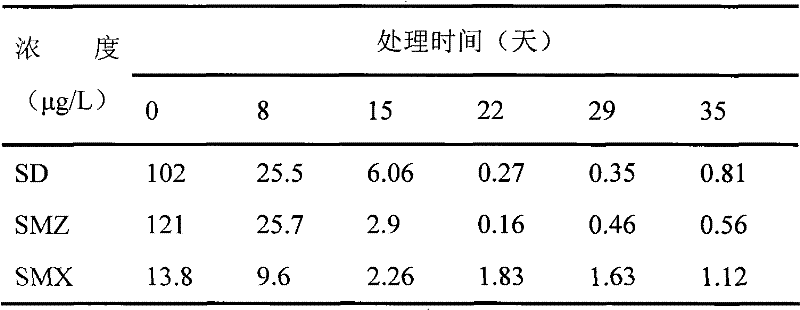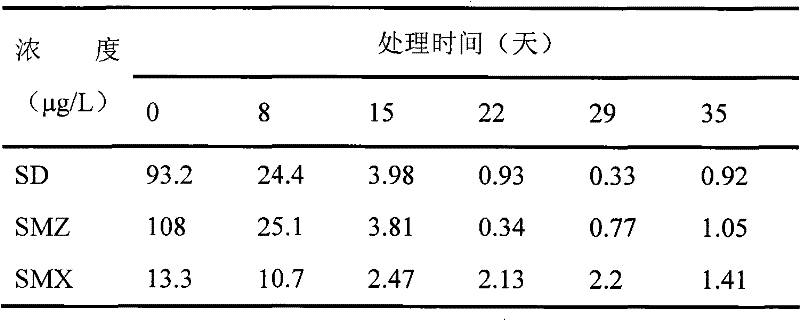Method for processing aquaculture wastewater containing antibiotics by utilizing plant floating bed
A technology for aquaculture wastewater and antibiotics, which is applied in biological water/sewage treatment, chemical instruments and methods, water/sludge/sewage treatment, etc., can solve the problem of not paying attention to antibiotics, etc. Direct discharge or reuse, the effect of inhibiting the growth of algae
- Summary
- Abstract
- Description
- Claims
- Application Information
AI Technical Summary
Problems solved by technology
Method used
Image
Examples
Embodiment 1
[0020] Breeding wastewater preparation method: Breeding manure was taken from a large-scale breeding in Jiangning District, Nanjing City, and stored at -20°C after freeze-drying. Cr All lower than 400mg / L), and mixed with sulfadiazine, sulfamethazine, sulfamethoxazole to make the concentration respectively 100μg / L, 100μg / L, 10μg / L, about 60L.
[0021] The polyethylene plastic foam board is used as a carrier, and holes are evenly drilled on it for cutting plants to form a floating bed. The ryegrass Dryan multiflora with a fresh weight of about 270 g was transplanted onto the floating bed carrier. The test site was chosen to be carried out in an outdoor environment, and only a simple plastic shed was built on the water tank to avoid rain. Water samples were taken about once every 7 days on average, and a total of 6 samples were taken. The sampling time is around 10 am, and the sampling volume is about 100-400mL. The water temperature is recorded at the same time as the samplin...
Embodiment 2
[0028] The breeding wastewater preparation method is the same as above.
[0029] The difference between the present embodiment and embodiment 1: the floating bed plant is replaced by the multi-flowered ryegrass of Waseyutaka, and the others are the same as in embodiment 1.
[0030] The results show that the removal effect of sulfonamide antibiotics in aquaculture wastewater is very obvious.
[0031] After 15 days of the experiment, the removal rates of sulfadiazine, sulfamethazine, and sulfamethoxazole in the water planted with ryegrass Waseyutaka reached 96.6%, 88.0%, and 97.3%, respectively. At the end of the experiment, the removal rates of sulfadiazine, sulfamethazine, and sulfamethoxazole reached 98.7%, 99.3%, and 88.8%, respectively. After the experiment, the fresh weight of the ryegrass variety Waseyutaka was 578g; sulfadiazine, sulfamethazine and sulfamethoxazole could be detected in the roots, but only sulfamethazine could be detected in the leaves.
[0032] See Tab...
Embodiment 3
[0036] The breeding wastewater preparation method is the same as above.
[0037] The difference between the present embodiment and embodiment 1: the floating bed plant is changed into the multi-flowered ryegrass that the variety name is Tachimasari. Others are with embodiment 1.
[0038] The results show that the removal effect of sulfonamide antibiotics in aquaculture wastewater is very obvious.
[0039] After 15 days of the experiment, the removal rates of sulfadiazine, sulfamethazine, and sulfamethoxazole in the water planted with ryegrass Tachimasari reached 95.7%, 81.4%, and 96.5%, respectively. At the end of the experiment, the removal rates of sulfadiazine, sulfamethazine, and sulfamethoxazole reached 99.0%, 99.0%, and 89.4%, respectively. After the experiment, the plant weight of the ryegrass variety Tachimasari was 569g; sulfadiazine, sulfamethazine and sulfamethoxazole could be detected in the roots, but only sulfamethazine could be detected in the leaves.
[0040...
PUM
 Login to View More
Login to View More Abstract
Description
Claims
Application Information
 Login to View More
Login to View More - R&D
- Intellectual Property
- Life Sciences
- Materials
- Tech Scout
- Unparalleled Data Quality
- Higher Quality Content
- 60% Fewer Hallucinations
Browse by: Latest US Patents, China's latest patents, Technical Efficacy Thesaurus, Application Domain, Technology Topic, Popular Technical Reports.
© 2025 PatSnap. All rights reserved.Legal|Privacy policy|Modern Slavery Act Transparency Statement|Sitemap|About US| Contact US: help@patsnap.com



